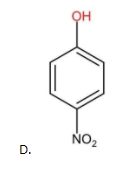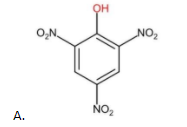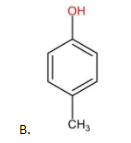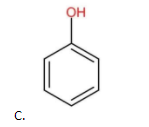
Which one is the most acidic compound?




Answer
505.2k+ views
1 likes
Hint: Acidity can be referred to as "electron pair instability", and this electron pair instability increases as the charge density on the phenol decreases. This means that the acidity should or does
increase with the increased positive charge on the group. And this increased charge on the group is due to the presence of the electron withdrawing group attached to the main group.
Complete step by step answer:
Acidity of a compound can be defined as its ability to donate a pair of electrons.
To determine the acidity of a compound, we need to see what type of substituent group is attached to the compound (phenol is this case).
A. If the substituent group attached is an electron releasing group (ERG), then they decrease the acidity of the compound due to their +I and +R effect. The more the number of ERG attached, the less will be the acidity of the compound. For example,
B. If the substituent group attached is an electron withdrawing group (EWG), then they increase the acidity of the compound due to their -I and -R effect. The more the number of EWG attached, the more will be the acidity of the compound. For example,
Now let us look at the options given to us one by one.

The above compound contains three EWG (

The above compound does not contain any

The above compound does not contain any

The above compound contains only one EWG (
Therefore, the decreasing order of the acidity of the compound is A > D > C > B.
Hence, the correct option is option (A).
Note: If the one nitro group in option D that is present in the para position was present in the meta position instead then also the p-nitrophenol is more acidic than m-nitrophenol. m-nitrophenol is also less acidic than o-nitrophenol in which the nitro group is present in the ortho position. But o-nitrophenol is less acidic than p-nitrophenol. Therefore the acidity order is p-nitrophenol> o-nitrophenol> m-nitrophenol.
increase with the increased positive charge on the group. And this increased charge on the group is due to the presence of the electron withdrawing group attached to the main group.
Complete step by step answer:
Acidity of a compound can be defined as its ability to donate a pair of electrons.
To determine the acidity of a compound, we need to see what type of substituent group is attached to the compound (phenol is this case).
A. If the substituent group attached is an electron releasing group (ERG), then they decrease the acidity of the compound due to their +I and +R effect. The more the number of ERG attached, the less will be the acidity of the compound. For example,
B. If the substituent group attached is an electron withdrawing group (EWG), then they increase the acidity of the compound due to their -I and -R effect. The more the number of EWG attached, the more will be the acidity of the compound. For example,
Now let us look at the options given to us one by one.

The above compound contains three EWG (

The above compound does not contain any

The above compound does not contain any

The above compound contains only one EWG (
Therefore, the decreasing order of the acidity of the compound is A > D > C > B.
Hence, the correct option is option (A).
Note: If the one nitro group in option D that is present in the para position was present in the meta position instead then also the p-nitrophenol is more acidic than m-nitrophenol. m-nitrophenol is also less acidic than o-nitrophenol in which the nitro group is present in the ortho position. But o-nitrophenol is less acidic than p-nitrophenol. Therefore the acidity order is p-nitrophenol> o-nitrophenol> m-nitrophenol.
Latest Vedantu courses for you
Grade 7 | CBSE | SCHOOL | English
Vedantu 7 CBSE Pro Course - (2025-26)
School Full course for CBSE students
₹45,300 per year
Recently Updated Pages
Master Class 10 Science: Engaging Questions & Answers for Success

Master Class 10 Social Science: Engaging Questions & Answers for Success

Master Class 10 Maths: Engaging Questions & Answers for Success

Master Class 10 English: Engaging Questions & Answers for Success

Class 10 Question and Answer - Your Ultimate Solutions Guide

Master Class 9 General Knowledge: Engaging Questions & Answers for Success

Trending doubts
Give 10 examples of unisexual and bisexual flowers

Draw a labelled sketch of the human eye class 12 physics CBSE

Differentiate between homogeneous and heterogeneous class 12 chemistry CBSE

Differentiate between insitu conservation and exsitu class 12 biology CBSE

What are the major means of transport Explain each class 12 social science CBSE

What is the difference between resemblance and sem class 12 social science CBSE




